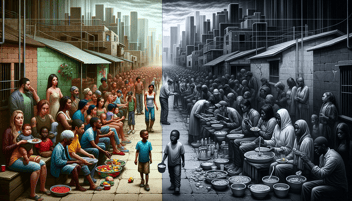C-E.A. Winslow was a prominent figure in public health in the U.S. and across the Western world. As a leading American bacteriologist and public health expert in the 20th century, he defined public health as the “science and art of preventing disease, prolonging life and promoting physical and mental health and well-being.”1

Today’s Public Health
But what does public health mean today?
Public health has evolved to address the changing needs of society and respond to emerging health challenges like the COVID-19 pandemic. Key areas of focus include:
- Assessing and monitoring population health.
- Investigating, diagnosing and addressing health hazards and root causes.
- Communicating effectively to inform and educate.
- Strengthening, supporting and mobilizing communities and partnerships.
- Creating, championing and implementing policies, plans and laws.
- Utilizing legal and regulatory actions.
- Enabling equitable access.
- Building a diverse and skilled workforce.
- Improving and innovating through evaluation, research and quality improvement.
- Building and maintaining a strong organizational infrastructure for public health.2
Today, public health is a multidisciplinary field that encompasses a broad range of activities and interventions aimed at promoting and protecting the health and well-being of individuals and populations.
Sustainability’s Impact on Public Health
So, what kind of impact does healthcare sustainability have on public health?
The Sustainable Health Equity Movement calls for promoting sustainable health equity as an ethical and human rights principle. It is a principle that guides national and international economic, social and environmental policies. To achieve it, social inequalities and environmental and global health must be addressed.3
Social determinants of health are the conditions in the places where people live, learn, work, play and worship that affect health risks and outcomes. According to the CDC, inequities in six key areas are interrelated and influence a range of outcomes, including:
- Social and community context (including discrimination and racism).
- Healthcare access and use.
- Neighborhood and physical environment.
- Workplace conditions.
- Income and wealth gaps.4
When organizations, employers, healthcare systems and providers, public health agencies and policymakers work together to develop policies around health equity, then communities can prevent health disparities. The CDC focuses on its CORE strategy to integrate health equity as a foundational element.
C – Cultivate comprehensive health equity science.
O – Optimize interventions.
R – Reinforce and expand robust partnerships.
E – Enhance capacity and workforce engagement.5
According to the McKinsey Health Institute, human influences on the environment continue to grow, resulting in disease generation and injuries that impact the quality of life, reduce productivity and weigh on health systems. That said, reducing environmental pollution and advancements in hygiene have increased human health and life expectancy during the past 150 years. But contaminated water, food, and air are still major causes of illness and death.6
Twenty-three percent of all global deaths could be prevented through healthier environments. And 250,000 additional death per year are expected to be caused by climate change between 2030 and 2050.7
Healthcare systems must be the forerunners for sustainability and preparedness.
Health Systems, Suppliers Working Together on Sustainability
According to the World Economic Forum, healthcare systems account for more than 4% of global CO2 emissions on an average basis. That figure is closer to 10% of national emissions for most industrialized nations and it’s more than both the aviation and shipping sectors.8
Hospitals emit 2.5 times more greenhouse gases than commercial buildings, so changing to renewable energy can have a major impact. And industry initiatives like the European trade association’s COCIR are helping to improve the energy efficiency and material efficiency of medical imaging equipment.9
Health systems and suppliers must work together on sustainability to impact public health. They can collaborate on sustainable procurement to ensure the sourcing of sustainable products and materials. This includes packaging, reduced waste and products that are environmentally friendly, and designing imaging equipment that increases energy efficiency to reduce emissions and address rising operational costs for care providers.
Health systems and suppliers can educate providers and the public on sustainability practices and their importance to public health through training programs, awareness campaigns, and educational materials.
SEKISUI Recognized for Sustainability in 2023 Global 100
SEKISUI has been included in the 2023 Global 100 Most Sustainable Corporations In The World Index – 2023 Global 100.10 It’s the sixth consecutive time that SEKISUI has been part of this important ranking. Corporate Knights Inc., a Canadian media and research B Corp., ranks large companies from across all sectors worldwide assessing sustainability performance from the ESG factors – Environmental, Social and Governance. Corporate Knights reviewed approximately 6,700 companies for its top 100 rankings in 2023.11
SEKISUI was recognized for achievements in sustainable revenue, including the sale of products and services that contribute significantly to the environment or society, sustainable investments like capital expenditure and R&D, and sustainability pay link.12
Vision 2030 is SEKISUI’s long-term vision and has identified “Innovation for Earth” as a vision statement, planning to make future on earth more livable and create peace of mind to promote a sustainable and innovative society.13
Read about SEKISUI’s commitment to sustainability.
References:
1CEA Winslow, who launched public health at Yale a century ago, still influential today, Yale News
210 essential public health services, American Public Health Association
3Achieving sustainable health equity, National Library of Medicine
4What is health equity?, CDC
5What is health equity?, CDC
6Sustainability and health, McKinsey Health Institute
7Sustainability and health, McKinsey Health Institute
8Here’s how healthcare can reduce its carbon footprint, World Economic Forum
9Here’s how healthcare can reduce its carbon footprint, World Economic Forum
10Sekisui Diagnostics ranks in top 100 most sustainable corporations, The Journal of Healthcare Contracting
11SEKISUI again one of the 100 most sustainable companies in the world, SEKISUI Europe
12Sekisui Diagnostics ranks in top 100 most sustainable corporations, The Journal of Healthcare Contracting
13SEKISUI again one of the 100 most sustainable companies in the world, SEKISUI Europe



Share Article